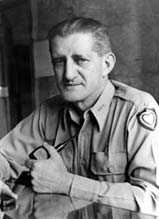John R. Hodge
| John Reed Hodge | |
|---|---|
 LTG John Reed Hodge | |
| Born |
June 12, 1893 Golconda, Illinois |
| Died |
November 12, 1963 (aged 70) Washington, DC |
| Allegiance |
|
| Service/branch |
|
| Years of service | 1917–1953 |
| Rank |
|
| Commands held | |
| Battles/wars |
World War I World War II
|
| Awards | Army Distinguished Service Medal |
General John Reed Hodge (June 12, 1893 – November 12, 1963) was a general in the United States Army.
Early life and Career
Being born in Golconda, Illinois, Hodge attended Southern Illinois Teachers College and the University of Illinois. After completing U.S. Army Officer Candidate School at Fort Sheridan, he entered military service as a Second Lieutenant of Infantry in 1917. He served in World War I in France and Luxembourg.
Between the Wars
Remaining in the Army following the end of the war, he taught military science at Mississippi State University from 1921–1925 and graduated from the Infantry School in 1926. After a posting to Hawaii, he graduated from the Command and General Staff School, the Army War College, and the Air Corps Tactical School.
World War II
At the beginning of World War II, Hodge was part of the staff of VII Corps. Being appointed Brigadier General, He started his combat career as part of the staff of general Joseph Lawton Collins in the Guadalcanal campaign. He then participated in the Bougainville campaign in 1943–1944. He was promoted to Major General during the Philippines Campaign in 1944. In 1945 he served on Okinawa, and he was promoted to Lieutenant General in August, becoming the commander of the XXIV Corps of the US Tenth Army.
Korean War
From 1945 to 1948, Hodge was the military governor of South Korea under the United States Army Military Government in Korea (USAMGIK). He took his corps to Korea under orders of General MacArthur, landing at Incheon on 9 September 1945. He was the commanding officer receiving the surrender of all Japanese forces in Korea south of the 38th parallel.
Hodge then returned to Fort Bragg, North Carolina to command V US Corps from 1948 to 1950. After the outbreak of the Korean War in 1950, he was named the Commanding General of the US Third Army, based in the United States of America, and not in Korea.
Hodge received a promotion to General on 5 July 1952 and his final assignment before retiring was as Chief of Army Field Services, 1952-1953. General Hodge retired from military service in June 30, 1953 and died in Washington, DC in 1963.
Decorations
| Distinguished Service Medal with oak leaf cluster | |
| Navy Distinguished Service Medal | |
| Legion of Merit | |
| Purple Heart with oak leaf cluster | |
| Air Medal | |
| World War I Victory Medal with silver award star | |
| Army of Occupation of Germany Medal | |
| American Defense Service Medal | |
| American Campaign Medal | |
| Asiatic-Pacific Campaign Medal with 2 silver award stars and arrowhead device | |
| World War II Victory Medal | |
| Army of Occupation Medal with “Japan” clasp | |
| National Defense Service Medal | |
| Korean Service Medal with 3 award stars and arrowhead device |
External links
| Military offices | ||
|---|---|---|
| Preceded by Alvan C. Gillem, Jr. |
Commanding General of the Third United States Army 1 August 1950 - 7 May 1952 |
Succeeded by William A. Beiderlinden |
See also
- List of Korea-related topics
- History of South Korea
- Military history of the United States
Not to be confused with U.S. Army General Courtney Hodges, who also served in World War II